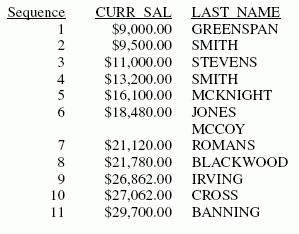x
Reference: Usage Notes for SET RANK
- The RNK. prefix operator
is not affected by the RANK parameter.
- The rank numbers
propagated to a HOLD file depend on the RANK parameter setting.
Example: Ranking
Values in a FOCUS Data Source
The
following request against the EMPDATA data source ranks salaries
in descending order by division. The RANK parameter is set to DENSE
(the default).
SET RANK = DENSE
TABLE FILE EMPDATA
PRINT LASTNAME FIRSTNAME
RANKED BY HIGHEST 12 SALARY
BY DIV
ON TABLE SET PAGE NOPAGE
END
On
the output, six employees are included in rank number 6. With dense
ranking, the next rank number is the next highest integer, 7.
RANK SALARY DIV LASTNAME FIRSTNAME
---- ------ --- -------- ---------
1 $115,000.00 CE LASTRA KAREN
2 $83,000.00 CORP SANCHEZ EVELYN
3 $80,500.00 SE NOZAWA JIM
4 $79,000.00 CORP SOPENA BEN
5 $70,000.00 WE CASSANOVA LOIS
6 $62,500.00 CE ADAMS RUTH
CORP CVEK MARCUS
WANG JOHN
NE WHITE VERONICA
SE BELLA MICHAEL
HIRSCHMAN ROSE
7 $58,800.00 WE GOTLIEB CHRIS
8 $55,500.00 CORP VALINO DANIEL
NE PATEL DORINA
9 $54,100.00 CE ADDAMS PETER
WE FERNSTEIN ERWIN
10 $52,000.00 NE LIEBER JEFF
11 $50,500.00 SE LEWIS CASSANDRA
12 $49,500.00 CE ROSENTHAL KATRINA
SE WANG KATE Running the same request with SET RANK=SPARSE
produces the following output. Since rank category 6 includes six
employees, the next rank number is 6 + 6.
RANK SALARY DIV LASTNAME FIRSTNAME
---- ------ --- -------- ---------
1 $115,000.00 CE LASTRA KAREN
2 $83,000.00 CORP SANCHEZ EVELYN
3 $80,500.00 SE NOZAWA JIM
4 $79,000.00 CORP SOPENA BEN
5 $70,000.00 WE CASSANOVA LOIS
6 $62,500.00 CE ADAMS RUTH
CORP CVEK MARCUS
WANG JOHN
NE WHITE VERONICA
SE BELLA MICHAEL
HIRSCHMAN ROSE
12 $58,800.00 WE GOTLIEB CHRIS
Example: Limiting
the Number of Sort Field Values
The
following request against the EMPDATA data source sorts salaries
in descending order by division and prints the 12 highest salaries.
The RANK parameter is set to DENSE (the default).
SET RANK = DENSE
TABLE FILE EMPDATA
PRINT LASTNAME FIRSTNAME
BY HIGHEST 12 SALARY
BY DIV
ON TABLE SET PAGE NOPAGE
END
On
the output, 12 distinct salary values are displayed, even though
some of the employees have the same salaries.
SALARY DIV LASTNAME FIRSTNAME
------ --- -------- ---------
$115,000.00 CE LASTRA KAREN
$83,000.00 CORP SANCHEZ EVELYN
$80,500.00 SE NOZAWA JIM
$79,000.00 CORP SOPENA BEN
$70,000.00 WE CASSANOVA LOIS
$62,500.00 CE ADAMS RUTH
CORP CVEK MARCUS
WANG JOHN
NE WHITE VERONICA
SE BELLA MICHAEL
HIRSCHMAN ROSE
$58,800.00 WE GOTLIEB CHRIS
$55,500.00 CORP VALINO DANIEL
NE PATEL DORINA
$54,100.00 CE ADDAMS PETER
WE FERNSTEIN ERWIN
$52,000.00 NE LIEBER JEFF
$50,500.00 SE LEWIS CASSANDRA
$49,500.00 CE ROSENTHAL KATRINA
SE WANG KATE Running the same request with SET RANK=SPARSE
produces the following output. Since six employees have salary $62,500,
that value is counted 6 times so that only 12 lines (seven distinct salary
values) display on the output.
SALARY DIV LASTNAME FIRSTNAME
------ --- -------- ---------
$115,000.00 CE LASTRA KAREN
$83,000.00 CORP SANCHEZ EVELYN
$80,500.00 SE NOZAWA JIM
$79,000.00 CORP SOPENA BEN
$70,000.00 WE CASSANOVA LOIS
$62,500.00 CE ADAMS RUTH
CORP CVEK MARCUS
WANG JOHN
NE WHITE VERONICA
SE BELLA MICHAEL
HIRSCHMAN ROSE
$58,800.00 WE GOTLIEB CHRIS
